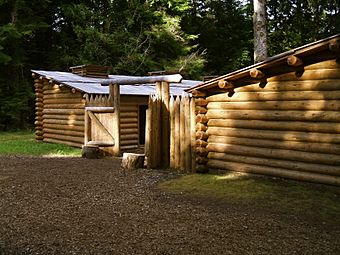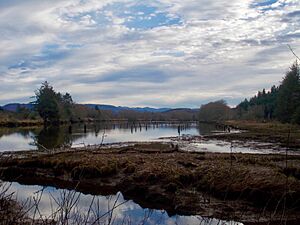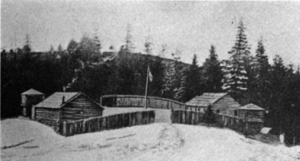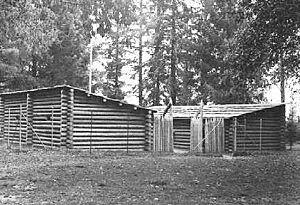Fort Clatsop facts for kids
Quick facts for kids |
|
|
Fort Clatsop National Memorial
|
|

The 2006 replica of Fort Clatsop
|
|
| Location | Clatsop County, Oregon, USA |
|---|---|
| Nearest city | Astoria, Oregon |
| Area | 125.2 acres (50.7 ha) |
| Built | 1805 |
| NRHP reference No. | 66000640 |
| Added to NRHP | October 15, 1966 |
|
The Fort Clatsop National Memorial located southwest of Astoria.
|
Fort Clatsop was a special camp built by the Lewis and Clark Expedition. This famous group of explorers stayed there during the winter of 1805–1806. The fort was located in what is now Oregon Country, close to where the Columbia River meets the ocean.
The camp was along the Lewis and Clark River, about five miles southwest of Astoria. It was the very last stop for the Corps of Discovery before they started their long journey back east to St. Louis.
The Lewis and Clark Expedition spent just over three weeks building Fort Clatsop. They lived there from December 8, 1805, until March 23, 1806.
Today, the site is part of the Lewis and Clark National Historical Park. The original Fort Clatsop fell apart because of the wet weather. A new fort was built in 1955, based on drawings from William Clark's journals. This replica was damaged by a fire in 2005. A new, more rugged replica was then built by many volunteers in 2006. It opened on December 9, 2006, and is now managed by the National Park Service.
Contents
Why Was Fort Clatsop Built?
In 1803, Thomas Jefferson, who was the President, bought a huge area of land from France. This was called the Louisiana Purchase. Most of this land had not been explored by Europeans. So, President Jefferson asked his secretary, Meriwether Lewis, and William Clark to lead an expedition.
Jefferson had several important goals for this trip. He wanted to find out what was in the new land, like different plants, animals, and natural resources. He also hoped to make friends with the Native Americans living there. Most importantly, Jefferson wanted to find a water route that went all the way to the Pacific Ocean. This would make travel from the Atlantic to the Pacific much faster.
Finding and Building the Fort
In late November 1805, the Lewis and Clark group was in what is now Washington. Local Clatsop Indians suggested they move to a spot along the Columbia River. The group decided to vote on where to spend the winter. Everyone got to vote, even Sacagawea, a young Native American woman, and York, an African American man.
They had three choices: stay in Washington, move further upriver, or follow the Clatsop Indians' advice and explore south of the river. The group chose to explore the southern shore.
Lewis went ahead with five men to scout the area. He hoped to find many elk, as the Clatsop people had said. Meanwhile, Clark and the others waited, fixing their worn-out clothes.

Finally, Lewis returned with good news: he had found a suitable place for winter. On December 7, 1805, the Corps of Discovery traveled to this spot. The men split into groups. Clark led some to the Pacific Ocean to make salt. Lewis divided the rest into hunters and tree-cutters for the fort.
Building the fort was hard work. It rained constantly, and strong winds made conditions difficult. By December 23, people started moving into the fort, even though it didn't have a roof yet. Everyone was inside by Christmas Eve. On Christmas Day, they named it "Fort Clatsop" after the local Native American tribe.
The fort was quite simple. It had two buildings surrounded by strong walls. All the men lived in one building. Lewis, Clark, Sacagawea, her husband Toussaint Charbonneau, and their son, Jean Baptiste, stayed in the other.
Winter Life at Fort Clatsop
The winter of 1805–1806 was very long and rainy. This made the Corps of Discovery bored and restless. They spent their time hunting deer and elk, which were plentiful. The meat spoiled quickly, but the animal skins were used to make clothes and moccasins.
Lewis spent much of his time at Fort Clatsop writing about their journey. He took notes on the wildlife, the land, and other interesting things. He also drew maps of the area. These maps would be very helpful for future settlers in the Pacific Northwest. Lewis and Clark also sometimes traded with the Clatsop Indians.
By the end of the winter, many of the men were feeling sick. They had various illnesses and respiratory problems. Everyone felt that leaving the fort would make them feel better.
Leaving Fort Clatsop
As the long winter ended, the men were eager to go back east. They were tired of being sick and eating elk meat all the time. It was also getting harder to find elk. Meriwether Lewis first planned to leave on April 1, but then changed it to March 20. They actually left two days later, on March 22, because of bad weather.
To travel back up the Columbia River and reach the mountains, the group needed canoes. The Clatsop people had many canoes but did not want to trade them. Eventually, they agreed to trade one canoe. Lewis decided they had to take a second canoe without trading, as they needed at least two boats for everyone to travel.
On March 22, the Corps of Discovery began their long journey back to St. Louis. Lewis decided not to send copies of his notes back by sea, which was sometimes done. Instead, he chose for the group to travel two different routes on the way back. This way, they could explore and see more of the territory.
What Happened to Fort Clatsop Later?
As a goodbye gift, Lewis gave Fort Clatsop to Coboway, the chief of the Clatsop tribe. Lewis and Clark did not need the fort anymore since they were going back east. Because of the heavy rain in the area, the original Fort Clatsop had completely rotted away by the mid-1800s.
The Clatsops used the fort for safety and other purposes. They also took some of the wood for other uses. The area soon became very important for the fur trade in the Pacific Northwest. The fort's location near the Pacific Ocean and the Columbia River made it a perfect spot for this trade. Many fur trading companies, like the American Fur Company and the Hudson's Bay Company, built their main offices in the region.
Since then, Fort Clatsop has been rebuilt twice. The first replica was built in 1955. It stood for 50 years until a fire destroyed it on October 3, 2005. Officials quickly promised to rebuild it. Firefighters were delayed by about 15 minutes because a 9-1-1 operator thought the fire was just fog. Investigators found no evidence that someone started the fire on purpose. It began in one of the soldiers' rooms, where a fireplace had been used earlier that day.
The 1955 replica took 18 months to build, much longer than the 3.5 weeks it took to build the original fort. After the fire, a second replica was built and finished in 2006. The fire also sparked new interest in studying the site's history, as digging for clues was not possible when the old replica was standing. The new 2006 replica was built with more accurate information about the original fort. It also has a fire detection system to keep it safe.
The current replica of the fort is not in the exact spot of the original. No remains of the first fort have ever been found. However, it is believed to be very close to where the original stood.
See also





